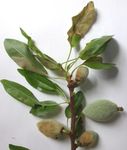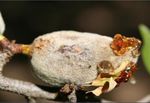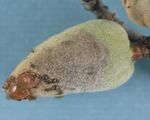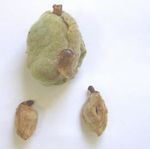Anthracnose disease of almond - (AL16005)
←
→
Page content transcription
If your browser does not render page correctly, please read the page content below
Fact sheet Anthracnose disease of almond (AL16005) Prepared by Suzanne McKay1, Brittany Oswald1, Len Tesorioro2, Jacky Edwards3 and Mark Sosnowski1 1 South Australian Research and Development Institute (SARDI), Plant Research Centre, Urrbrae, South Australia 2 New South Wales Department of Primary Industries, Ourimbah, New South Wales 3 Agriculture Victoria, AgriBio Centre, Bundoora, Victoria Background Anthracnose disease of almond in Australia is caused by several species of the fungus Colletotrichum (de Silva et al 2021). The pathogen mainly affects young almond hulls but leaves, blossom and woody tissue can also be affected. Colletotrichum spp. also cause anthracnose on a wide range of other perennial crops, e.g. pistachio, orange, olive, avocado and grape, with serious yield losses reported (Cannon 2012). Symptoms On almond, typical symptoms on young hulls are orange or tan-coloured, circular, sunken lesions (Fig 1A, H, G and I). Infected hulls will eventually shrivel, die and remain attached as ‘mummies’ (Fig 1K), providing a source of inoculum for the next season. Orange or tan-coloured gum exudes from lesions on older hulls (Fig 1E, F, K). ‘Water-soaked’ lesions are observed on the leaf margins (Fig 1I, J), which eventually spread resulting in whole-leaf necrosis. Dieback is seen on spurs and twigs with infected fruit or leaves attached (Fig 1K). This is thought to be caused by toxins produced by the fungus (Förster and Adaskaveg 1999; López-Moral et al. 2017). Symptoms of blossom blight due to anthracnose have been observed on almond in California (Förster and Adaskaveg 1999) but not in Australia (McMichael 2000, McKay et al. 2014), yet, Colletotrichum spp. have been isolated from apparently healthy almond blossom (McMichael 2000, McKay et al. 2014). However, other fungi e.g. Botrytis and Monilinia spp. cause blossom blight and rot respectively on almond in Australia (Delaporte et al. 2009).
A B C
D E F
G H I
J
K
Figure 1. Symptoms of anthracnose on almond: A-H. sunken, orange-coloured lesions and gum exuding
from infected hulls; I-J. water-soaked lesions and marginal necrosis on leaves and K. spur and twig
dieback with attached anthracnose mummies.
Photos attributed to: F-Doll (2010); G -López-Moral et al (2017) and I -Doll (2016).
Conditions for anthracnose disease development
Anthracnose disease development is favoured by mild to warm temperatures (~10-25oC) and wet
weather (Shabi and Katan 1983, Adaskaveg and Förster 2000). When these conditions occur at the
same time as when plant tissues are susceptible i.e. young fruit and leaves in late winter and early
spring, there is an increased risk of anthracnose disease development (McKay et al. 2014). In these
warm, wet conditions, spores of Colletotrichum spp. reproduce rapidly and are spread by wind and rainsplash to adjacent plant parts. Once spores land on susceptible tissue, infection occurs quickly i.e. between 3 and 48 hours, under suitable environmental conditions (Wharton and Diéguez-Uribeondo 2004). Primary infection occurs in late winter and early spring following the first rain event (McKay et al. 2014). Secondary infections occur when plant material is still susceptible, and the weather conditions are optimal for infection (McKay et al. 2014) with several disease cycles possible in a season. Susceptibility of fruit and leaves to infection decreases with age with new infections rarely occuring on mature hulls. New infections have been observed on mature fruit in California (Adaskaveg and Förster 2000) and Australia (McMichael 2000). However other studies, carried out in Australia (McKay et al. 2014) and Israel (Shabi and Katan 1983) found no evidence of new infections on green hulls greater than ~3 months old. In Australia, the commonly planted varieties of Carmel, Price and Nonpareil are all suscpetible (McMichael 2000, McKay et al. 2014) however, Nonpareil may be less so (Adaskaveg and Förster 2000, McMichael 2000, McKay et al. 2014). Other varieties planted in Australia have not been evaluated for susceptibility to anthracnose but based on findings from other countries, most commonly planted varieties are likely susceptible (Adaskaveg and Förster 2000). Disease management Successful management of anthracnose begins early in the season at pink-bud stage (McMichael 2000). McMichael (2000) found that all new tissue must be well protected i.e. good spray coverage with spray intervals not exceeding 12 days from pink bud. Ensuring good spray coverage is essential for successful management. In Australia, the fungicides registered to control anthracnose are those containing the single active ingredients of either captan (group M3) or azoxystrobin, (group 11) as well as a product containing both pyraclostrobin (Group 11) and fluxapyroxad (group 7). There is a current APVMA permit for the use of propiconazole (group 3) for almond anthracnose control. However, sprays to specifically control anthracnose need to be considered as part of the overall spray program. Some fungicides, registered for control of foliar diseases other than anthracnose, likely have efficacy against anthracnose and this needs to be taken into account when planning a spray program. Anthracnose mummies are the main source of inoculum but the fungus can also survive in old, infected wood (McKay et al. 2014). Although, removal of these parts might decrease the carry-over of inoculum to the following season, there has been no research to show that this is an effective management strategy of almond anthracnose. Nevertheless, removal of dead wood opens the canopy, thereby increasing airflow and results in conditions less suitable for infection and disease development (Jeffries et al 1990). Controlling humidity within the canopy can also be achieved by minimising the use of overhead sprinklers, fixing irrigation leaks promptly, avoiding overwatering and improving drainage. These strategies are also recommended for the management of other diseases where moisture is conducive for disease e.g. Phytophthora diseases, hull rot and bacterial spot. Ideally, tolerant or resistant cultivars would assist with disease management, but these are yet to be developed.
Key Points
• anthracnose is a fungal disease that mainly affects young nuts and leaves
• all cultivars are likely susceptible
• disease development is favoured by mild to warm and wet conditions
• infection mainly occurs in late winter and early spring
• fungicides should be applied early in the season prior to the onset of symptoms.
Acknowledgement
This project has been funded by Hort Innovation using the almond research and development levy and
funds from the Australian Government.
For more information on the fund and strategic levy investment, visit horticulture.com.au
References
Delaporte K., Kane S. and McMichael P., 2009, Almond Industry Pest and Disease Guide, 2009-2010,
The Almond Board of Australia, South Australia.
de Silva D.D., Mann R.C., Kaur, J., Ekanayake N., Sawbridge T.I., McKay S., Taylor P.W.J. and
Edwards, J., 2021, ‘Revisiting the Colletotrichum species causing anthracnose on almond in Australia’,
Australasian Plant Pathology, vol. 50, 267-279.
Doll D., 2010, Almond anthracnose-An ugly spring disease. http//www.thealmonddoctor.com
Doll D., 2016, Bacterial spot v/s Anthracnose v/s Plantbug. http//www.thealmonddoctor.com
Förster H. and Adaskaveg J., 1999, ‘Identification of subpopulations of Colletotrichum acutatum and
epidemiology of almond anthracnose in California’, Phytopathology, vol. 89, 1056-1065.
Jeffries P., Dodd J.C., Jeger M.J. and Plumbley, R.A., 1990, ‘The biology and control of Colletotrichum
species on tropical fruit crops’, Plant Pathology, vol. 39, 343-366.
López-Moral A., Raya-Ortega M.C., Agustí-Brisach C., Roca L.F., Lovera M., Luque F., Arquero O. and
Trapero A., 2017, ‘Morphological, pathogenic and molecular characterization of Colletotrichum acutatum
isolates causing almond anthracnose in Spain’, Plant Disease, vol. 101, 2034-2045.
McKay S.F., Shtienberg D., Sedgely M. and Scott E.S., 2014 ‘Anthracnose on almond in Australia:
Disease progress and inoculum sources of Colletotrichum acutatum’, European Journal of Plant
Pathology, vol. 139, 773-783.
McMichael P.A., 2000, HRDC Project NT 98004. The control and management of ‘anthracnose’ of
almonds. Scholefield Robinson Horticultural Services Pty Ltd, Netherby, South Australia.
Wharton P.S. and Diéguez-Uribeondo J., 2004, ‘The biology of Colletotrichum acutatum’, Anales del
Jardin Botanico de Madrid, vol. 61, 3-22.You can also read


























































